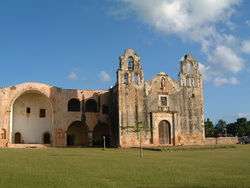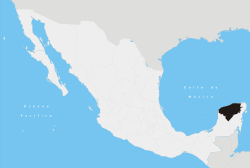Maní, Yucatán
Maní is a small city in Maní Municipality in the central region of the Yucatán Peninsula, in the Mexican state of Yucatán. It is about 100 km to the south south-east of Mérida, Yucatán, some 16 km east of Ticul. The village of Tipikal lies 6 km to the east.[2]
Maní | |
|---|---|
City | |
 Church and Convent of San Miguel in Maní | |
Location of the municipality of Maní in Yucatán | |
 The state of Yucatán, México (dark) in the Yucatán Peninsula | |
 Maní Location of the municipality of Maní in Yucatán  Maní Maní (Mexico) | |
| Coordinates: 20°23′N 89°24′W | |
| Country | |
| State | |
| Municipality | Maní Municipality |
| Government | |
| • Municipal President | Santos Román Dzul Beh. 2012–2015 |
| Elevation | 26 m (85 ft) |
| Population (2010[1]) | |
| • Total | 4,146[1][note 1] |
| Demonym(s) | Maniense |
| Time zone | UTC-6 (Central Standard Time) |
| • Summer (DST) | UTC-5 (Central Daylight Time) |
| Postal Code | 97850 |
| Area code(s) | 997 |
| Website | www |
The population is currently around 4000,[1] similar now to the estimated 4500 in the 16th century.
History
Maní's four millennium[2] existence historically involves mostly its early Maya period, followed in recent centuries by its Spanish conquistador and religious period. Its Mexican period beginning over a century ago involved conflict.
Early history
Maní has been continuously occupied for approximately 4000 years.[2] In the postclassic Mesoamerican era it was home to the Tutul-Xiu Maya[2] dynasty, which moved their capital here from Uxmal in the 13th century. The Xiu were the dominant power in the western Yucatán after the fall of Mayapan in 1441.[3] Maní served as the main religious center in honor of the deity Kukulcan (Cukulcan, Topiltzin Quetzalcoatl)[4][5] for the Maya with an annual chic kaban[6] festival until 1341.[7]
With the arrival of the Spanish the Xiu of Maní allied themselves with the Spanish and assisted in the conquest of the rest of the peninsula.[8]
Maya book burning
On 12 July 1562,[9] Friar Diego de Landa, who held the office of inquisitor before the Monastery of San Miguel Arcángel, held an auto de fe Inquisitional ceremony in Maní, burning a number of Maya hieroglyphic books and a reported 5000 idols, saying that they were "works of the devil".[9] The number of books burned is disputed. Landa claimed only burning 27. This act and numerous incidents of torture at the monastery were used to speed the mass adoption of Roman Catholicism throughout the region.
Landa's burning of these sacred books with Mayan writing and the subsequent reaction were described by him as follows:[10]
We found a large number of books in these characters and, as they contained nothing in which were not to be seen as superstition and lies of the devil, we burned them all, which they (the Maya) regretted to an amazing degree, and which caused them much affliction.[10]
.jpg)
Guerra de Castas
Maní was involved in part of the multi-decade conflict in the Guerra de Castas, the Caste War of the Yucatán. An engraved stone narrates an episode of the event for Maní in 1850.
Church and Convent of San Miguel
| Year | Pop. | ±% |
|---|---|---|
| 2000BC | initial | — |
| 16th century AD | 4,500 | — |
| 2000[1] | 4,664 | +3.6% |
| 2005[1] | 3,915 | −16.1% |
| 2010[1] | 4,146 | +5.9% |
| INEGI: Archivo Histórico de localidades | ||
The town has an old Franciscan monastery established in 1549,[note 2] the Parroquia y Exconvento de San Miguel Arcangel. The large building was built using cut stones from many of the Pre-Columbian structures of Maní. A large open chapel is on the north side with the two bell gables on the church facade. Inside, the apse vault has some early colonial era fresco murals. The nave interior houses three Baroque carved altars with statues of saints and images. Restoration work on the monastery building and its artwork began in 2001.
Surroundings
The area around Maní is largely devoted to agriculture, principally henequen, maize, cattle, and fruit. Hammocks are made in the city.
Festivals
Each 15 to 24 August Maní holds a festival in honor of the Virgin of the Assumption. Each 3 January is a festival of the Virgin of Candlemas.
Photo gallery
 House in the Main Square
House in the Main Square A street
A street An arch at the Church
An arch at the Church An Inscription at the Church
An Inscription at the Church- San Miguel Arcangel, Mani
Notes
- The estimated population in the 16th century was 4500. The 2000 population was 4664. The 2005 population was 3915. The recent 2010 population is 4146. A 2014 estimate has 3978.
- Established 1549; built between 1548–57.
Citations
- INEGI.
- Lougheed.
- Solís.
- Bancroft, p. 699.
- Nicholson.
- Bancroft, p. 700.
- Sharer, p. 552.
- Clendinnen, Cost, p. 98.
- Nimoy, In Search Of...
- Clendinnen, Ambivalent, p. 70.
References
English
- Bancroft, Hubert Howe (1883), The Native Races of the Pacific States, Vol. II: Civilized Nations, Bancroft & Co., San Francisco, 1883 edition.
- Clendinnen, Inga (2003), Ambivalent Conquests: Maya and Spaniard in Yucatan, 1517–1570 (2nd ed.), New York: Cambridge University Press, ISBN 0521820316.
- Clendinnen, Inga (2010), "Disciplining the Indians: Franciscan Ideology and Missionary Violence in Sixteenth Century Yucatán" (essay; chapter 3), The Cost of Courage in Aztec Society: Essays on Mesoamerican Society and Culture, Cambridge University Press, ISBN 978-0-521-51811-6 (hardback).
- Lougheed, Vivien (2009), Travel Adventures: Yucatan – Chetumal, Merida & Campeche, "Chapter 4.10.2.9: Mani", Hunter Travel (guides), Hunter Publishing, Inc., Edison, New Jersey.
- Nicholson, H.B. (2001), Topiltzin Quetzalcoatl: The Once and Future Lord of the Toltecs, University Press of Colorado; Boulder, Colorado.
- Nimoy, Leonard (narrator) (1978), In Search of... (TV series), Episode 28 (Series 2, Episode 4; airdate 1978 January 7), "Mayan Mysteries", Alan Landsburg Productions, copyright 1977.
- Sharer, Robert J. (1994), The Ancient Maya, 5th edition.
Spanish
- INEGI (2010); "Principales resultados por localidad 2010 (ITER)"., Instituto Nacional de Estadística y Geografía [National Institute of Statistics and Geography (Mexico)].
- Solís, Juan F. Molina (1896); Historia Antigua de Yucatán, La ruina de Uxmal y la fundación de Maní. Supplemento (1896), Biblioteca Virtual de Yucatan.
External links
| Wikimedia Commons has media related to Maní. |
